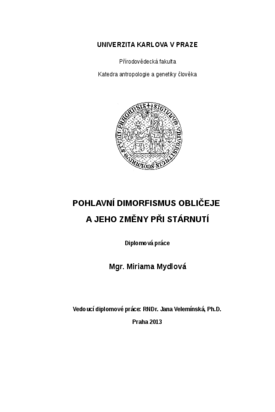Pohlavní dimorfismus obličeje a jeho změny při stárnutí
Sexual dimorphism of the face and changes during senescence
diplomová práce (OBHÁJENO)

Zobrazit/
Trvalý odkaz
http://hdl.handle.net/20.500.11956/54340Identifikátory
SIS: 113788
Kolekce
- Kvalifikační práce [19614]
Autor
Vedoucí práce
Oponent práce
Blažek, Vladimír
Fakulta / součást
Přírodovědecká fakulta
Obor
Antropologie a genetika člověka
Katedra / ústav / klinika
Katedra antropologie a genetiky člověka
Datum obhajoby
11. 9. 2013
Nakladatel
Univerzita Karlova, Přírodovědecká fakultaJazyk
Čeština
Známka
Velmi dobře
Klíčová slova (česky)
forma a tvar, geometrická morfometrie, lidský obličej, pohlavní dimorfismus, stárnutíKlíčová slova (anglicky)
ageing, form and shape, geometric morphometry, human face, sexual dimorphismLidský obličej v průběhu života kontinuálně mění svůj tvar, což neustává ani po zastavení růstu jedince (Hennessy a Moss, 2001; Williams a Slice, 2010). Předkládaná práce aplikuje metodu geometrické morfometrie na studium pohlavního dimorfismu lidského obličeje v průběhu stárnutí. Pohlavní dimorfismus může být definován jako systematická odlišnost ve formě mezi jedinci odlišného pohlaví stejného druhu (Samal et al., 2007). Morfologické změny, související s procesem stárnutí lidského obličeje, byly analyzovány na základě dat, získaných z povrchových 3D modelů lidských obličejů metodami geometrické morfometrie (Dense Correspondence Analysis, Principal Component Analysis, Shell-to-Shell Deviation) a vícerozměrné statistiky (Scree Plot, Hotellingův Tš-test, permutační test, MANOVA). Z výsledků práce je zřejmé, že forma (velikost včetně tvaru) a tvar obličeje mužů i žen se během stárnutí signifikantně mění. Zatímco se jedinci ve věku 20-40 let odlišují formou obličeje, nejstarší muži ve věku 61-82 let jsou od žen rozlišitelní podle tvaru obličeje. Obličeje jsou nejvýrazněji pohlavně dimorfní ve střední věkové kategorii (41-60 let), kdy jsou mezi jednotlivci významné rozdíly nejen velikosti spojené s tvarem, ale také pouze diference tvarové - tj. po odstranění vlivu velikosti. Klíčová slova: forma a...
The human face shape is constantly changing during human life, even after one`s development stop (Hennessy a Moss, 2001; Williams a Slice, 2010). This work applies geometric morphometry method on study of sexual dimorphism of human face through ageing. Sexual dimorphism can be defined as a systematic difference in form between individuals of different sex of the same kind (Samal et al., 2007). Morphological changes, related to the process of ageing of human face, were analysed on data obtained from 3D surface models of human faces using methods of geometric morphometry (Dense Correspondence Analysis, Principal Component Analysis, Shell-to-Shell Deviation) and multivariatel statistics (Scree Plot, Hotelling`s Tš-test, permutational test, MANOVA). The work results indicates that the form (size with shape) and shape of men and women faces significantly change through ageing. Individuals aged between 20-40 years differ in form of the face, however the oldest men aged between 61-82 years differ from women only in shape of the face. The biggest differences in sexual dimorphism are in the middle age category (41-60 years), where there are significant differences not only in form, but also considering shape alone. Key words: ageing, form and shape, geometric morphometry, human face, sexual dimorphism 7
